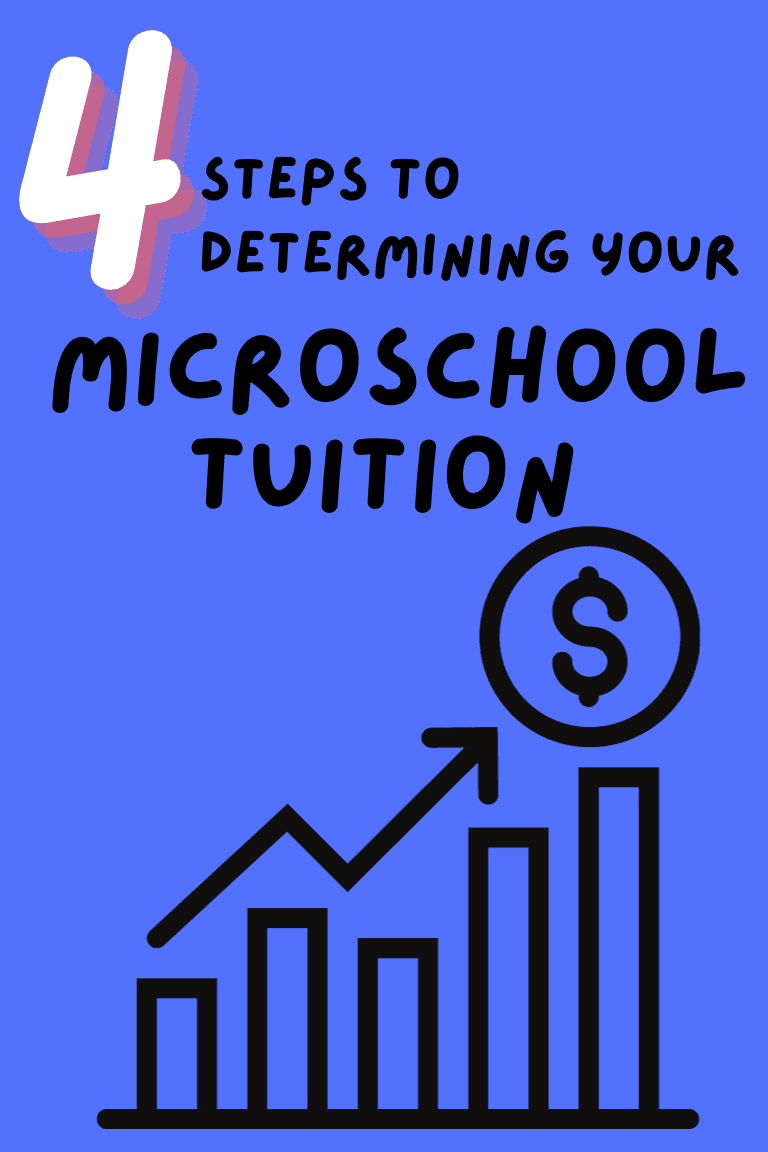If you are trying to figure out how much you should charge for your microschool’s tuition, you are in the right place.
It also means you are among the growing number of teachers taking their power back. Instead of abandoning their teaching career, they are starting microschools.
You are among the brave who are reshaping our educational landscape, not only for ourselves but also for the students we teach. I am here for it all!
It’s my pleasure to help you figure this out. Let’s jump in.
How do microschools make money?
The way microschools make money is through tuition payments. Depending on where the microschool is located, the state helps to pay this tuition via school choice funds. Some microschools are awarded grants. Any balance remaining would be the responsibility of the parent.
What should I charge for my microschool tuition?
As a general rule, when deciding your tuition pricing, you should consider: 1. What your business structure will be; 2. The market where you are; 3. Your value; and 4. Your budget to ensure the tuition rate will cover all costs.
I wish there were a clearer answer. This will look different for each microschool owner because there are several different variables to consider.
However, considering the following steps will help you determine a figure that makes sense for you and the families you serve. In addition, use the calculator at the end of this article to help.

1. Decide on your business structure.
The first thing you will have to understand is that your microschool is a business. Therefore, you have to decide what your business structure will be.
Will it operate as a non-profit business or a for-profit business? To help you understand your options, read this article on legal forms of business organization I wrote.
No matter what your business structure is or whether you run it as a tutoring center, a homeschool cooperative, or a more traditional setting, you will charge tuition.
Triumph School, my micro-school, is a nonprofit (there are pros and cons). I wanted the option of going after grants because many of my students are underserved.
I intentionally target this group: families who are not normally looking for private education because they can’t afford it. However, their student desperately needs one.
Currently, Triumph’s tuition rate is $11K. However, none of my students actually pay that amount. The reason is twofold:
- I write grants and I fundraise (you can fundraise with a for-profit too; however, it’s not tax-deductible).
- I also receive funds from our state school choice program.
No matter where the money is coming from, this is the amount I need to keep the doors open based on a group of 5 to 10 students.
2. Understand the market where you are.
If you have a business plan, then you have done a market analysis of some sort. Click here for my school business plan template if you need one.
I recommend you find your competitors. What are they charging? You can also check the average tuition for your area.
Know who your target market is. Can they afford to pay the average amount of tuition for your area? Knowing this will give you a starting point to determine your tuition.
3. Determine the value your program offers families.
What will your program offer? Think about the value parents get; what is that? What outcomes can parents expect from their children attending your program?
Match the value to the tuition. If you get results and a parent can afford to pay, they will have no problem paying for a quality education.
4. Complete a budget.
If you have a business plan, you may have already completed your budget. However, if you haven’t, I highly suggest that you get started with a detailed one.
Feel free to use my school budget template (coming soon, check back). I always have two: one bare-bones version and two, a dream version.
You can use this calculator to get started, which will give you a starting idea.
Remember, you are now a business owner working in the private sector. So, you may not start out being able to pay yourself what you are worth in the beginning.
What do you want your salary to be?
Will you have an aide or another teacher? What will their salary be?
How many students will you aim for?
Facility cost?
Don’t be afraid of that number. Remember, this is also why you have one budget that represents two different scenarios.
In addition, you can create a sliding scale for lower-income families to offset tuition costs.
Creating a budget that balances expenses against generated tuition is crucial for a sustainable micro-school. Remember, Rome wasn’t conquered overnight.
I created a simple calculator to help you figure out your tuition. Once you have answers to the questions above, put them in the calculator below to determine your tuition price.
School Tuition Calculator
Your tuition should be around: $0
Other Things That Impact Microschool Tuition
- Microschool tuition costs vary widely. It can range from $4,000 to $25,000 per academic year.
- The teaching staff of microschools is not always credentialed teachers. This can impact the amount “teachers” are paid.
- Microschools don’t always use traditional facility space. This can impact the budget as well.
- Some microschools are hybrids. Therefore, they don’t always attend school Monday–Friday.
- Microschooling is more of a mentality than a specific legal distinction in most cases; there are many ways to be innovative in running one and saving money effectively.
- Microschools are small, independent start-ups; there are also microschool networks with learning groups across multiple states.
Understanding Mircoschools Better
Here are the three most common formats you’ll see microschools take:
Learning centers for homeschoolers. A report by the National Microschooling Center indicates that about 44% of microschools take this format, catering to homeschool students. In states with strict regulations on private schools, families seeking custom group learning may find this format most accessible.
In-person private schools. Some microschools are private schools. These microschools have done the work of meeting their state’s requirements for private education. Families register their children as students in private schools.
Hybrid schools. Another popular format for microschooling is the hybrid model, which combines in-person learning at a brick-and-mortar school for a few days a week and at-home learning for the rest of the week.
Conclusion: Microschool Tuition
I hope this has given you a clearer idea of what your microschool tuition rates will be. I also hope you stay on course. It isn’t easy, but it is such a rewarding journey.
You might like these topics too:

I am also looking to open a microschool for the exact students and families you are servicing! I’m glad I came across this article, it gives me hope because I’m not the only one!
You are not the only one and you can do it!!!!